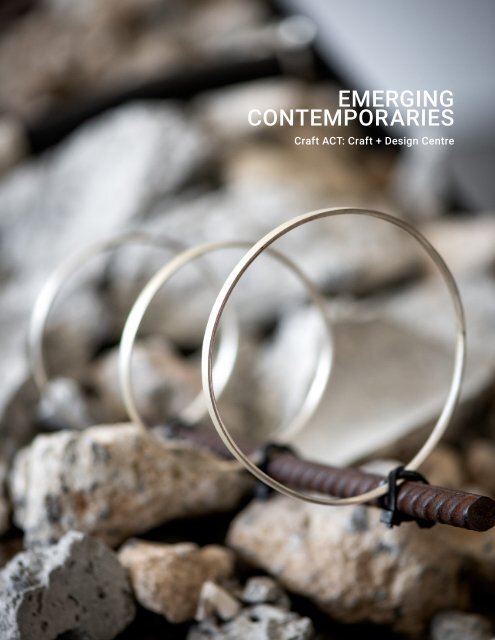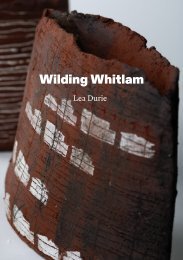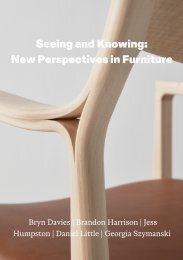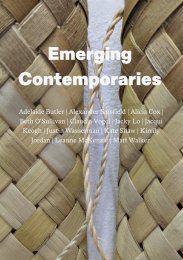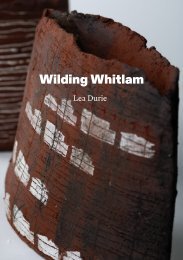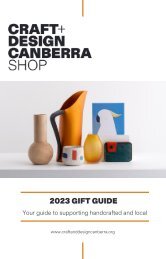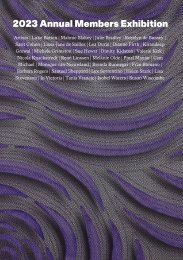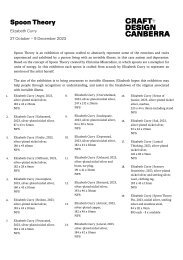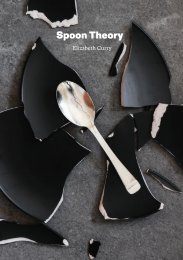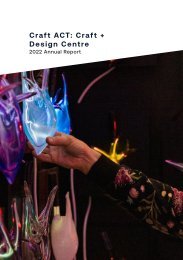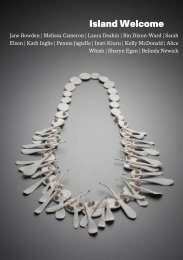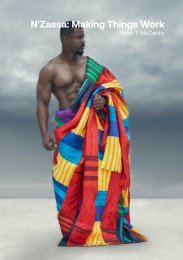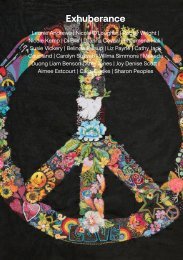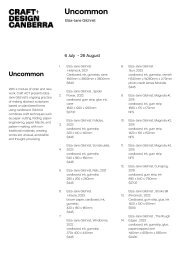2023 Emerging Contemporaries Catalogue
Create successful ePaper yourself
Turn your PDF publications into a flip-book with our unique Google optimized e-Paper software.
EMERGING<br />
CONTEMPORARIES<br />
Craft ACT: Craft + Design Centre
Craft ACT: Craft + Design Centre is partially supported by the ACT<br />
Government, the Visual Arts and Craft Strategy – an initiative of<br />
the Australian State and Territory Governments, and the Australia<br />
Council for the Arts – the Australian Government’s arts funding and<br />
advisory body.<br />
Craft ACT: Craft + Design Centre acknowledges the Ngunnawal<br />
people as the traditional custodians of the ACT and surrounding<br />
areas. We honour and respect their ongoing cultural and spiritual<br />
connections to this country and the contribution they make to the<br />
life of this city and this region. We aim to respect cultural heritage,<br />
customs and beliefs of all Indigenous people.<br />
Craft ACT: Craft + Design Centre<br />
Tues–Fri 10am–5pm<br />
Saturdays 12–4pm<br />
Level 1, North Building, 180 London Circuit,<br />
Canberra ACT Australia<br />
+61 2 6262 9333<br />
www.craftact.org.au<br />
Cover image: Matthew Freeman, Reactive Armour, 2022. Photo: Tim Bean Photography.<br />
Page 4-5: Sabina Moore, Fragmented Memory, 2022. Photo: Tim Bean Photography.
<strong>Emerging</strong> <strong>Contemporaries</strong><br />
Adelina La Vita | Dianne Bourke | Dominic Gowans | Elliane Boulton |<br />
Finnan Solomon Walker | Gabriela Renee | Juniper Maffescioni | Matthew<br />
Freeman | Molly Desmond | Nathan Nhan |Richard Caines | Ross<br />
Wortham | Sabina Moore | William Armstrong Guy<br />
Craft ACT: Craft + Design Centre<br />
2 February – 18 March <strong>2023</strong>
Thought begins, again, anew.<br />
EXHIBITION ESSAY | Tara Elisabeth Jeyasingh + Christian Sirois<br />
In What is Philosophy?, first<br />
published in English in 1994,<br />
Gilles Deleuze and Felix Guattari<br />
conceptualise the work of art as<br />
a ‘bloc of sensation’ - genuinely<br />
capable of creating something new<br />
by means of generating the feel or<br />
sensation of something different.<br />
And this something different might,<br />
just might, open up other ways<br />
of thinking, living, speaking, and<br />
acting. As Simon O’Sullivan writes,<br />
art “can be the seed of something<br />
genuinely new. In an increasingly<br />
homogenised and homogenising<br />
neoliberal present that offers only<br />
more of the same - a present that<br />
overcomes all options - these<br />
points of difference can become<br />
politically charged” (2016 p.82).<br />
This chance for sensation takes<br />
place at the surface: it exists in<br />
the very material of the artwork,<br />
from “the material itself, the smile<br />
of oil, the gesture of fired clay,<br />
the thrust of metal, the crouch<br />
of Romanesque stone, and the<br />
ascent of Gothic stone” (Deleuze<br />
& Guattari 1994 p.166). The surface<br />
is where the maker and the<br />
audience meet and exchange via<br />
the medium of the work of art itself,<br />
made possible through the skill and<br />
style of the artist. Intermediary yet<br />
immediate.<br />
<strong>Emerging</strong> <strong>Contemporaries</strong> opens a<br />
window onto this intimate process<br />
which takes place between the<br />
artist and their craft, their intentions<br />
and their material, the sides of<br />
these terms becoming increasingly<br />
blurred and increasingly connected.<br />
From this, a fluency emerges - a<br />
style or consistency, a process,<br />
of which the artists shown<br />
here are just at the beginning<br />
of. The exhibition is brimming<br />
with potential, for the artists and<br />
spectators alike.<br />
Art inspires thought, and thought<br />
begins, again, anew. Traditional<br />
conceptions of ‘thought’ and<br />
‘knowledge’ restrict these to some<br />
pre-existing ‘pool’ of which we<br />
are tasked with accessing and<br />
extracting from. Whilst noble, this<br />
limits the world to what already<br />
exists, uncovered or not. But<br />
when the world is re-viewed<br />
instead as being radically open<br />
and constructed, as taking place<br />
in process and in place, thinking<br />
instead becomes capable of<br />
creating genuine novelty and<br />
change. Art becomes tasked with<br />
the germination of such radical<br />
opportunity, and politically the<br />
current state of affairs begins to<br />
look a little less impenetrable.<br />
That encounter with the new, that<br />
fresh and excitable feeling when<br />
an idea pops into your head (how<br />
could it ever have not been there?)<br />
is a rare treat: there is no way of<br />
telling where such moments will<br />
spring from, what will trigger them,<br />
where we will be, what time of day,<br />
or in whose company. And there<br />
is no telling just where the idea<br />
will go - written down perhaps, or<br />
carried into conversation, across<br />
dinner tables and groups of<br />
friends, changing the tone of your<br />
morning coffee or from finding<br />
new pleasure in sitting in front of<br />
your favourite vista. That <strong>Emerging</strong><br />
<strong>Contemporaries</strong> might provide<br />
such a micro-rupture speaks to<br />
the intimate relationship between<br />
the artist and their material,<br />
that malleable surface tension<br />
which might provide a different<br />
configuration of the present - the<br />
shimmer of a beginning, again,<br />
anew.<br />
Tara Elisabeth Jeyasingh is a current cultural geography PhD student at UNSW Canberra and assistant manager of Blonde Concept in Braddon, Canberra.<br />
Her research engages the philosophies of Gilles Deleuze, Felix Guattari and Édouard Glissant to explore how the arts can generate politically and ethically<br />
significant change in individual thinking and wider world processes. She has previously written on these capacities in cinema, and her current PhD project is<br />
thinking this through fashion and style.<br />
Christian Sirois is a curator, artist, and cultural geography PhD candidate at UNSW Canberra, as well as the gallery and exhibition manager at Craft ACT:<br />
Craft and Design Centre. His research is centered around curation, affect, and cultural conservation through creative and multisensory fieldwork methods,<br />
exploring the types of knowledge that can be produced when we engage with sensory networks as epistemological systems.<br />
Image: Adeline La Vita, Trunk Tower, 2022. Photo: Tim Bean Photography<br />
Page 6-7: Richard Caines, BioPod Series, 2022. Photo: Time Bean Photography
Adelina La Vita<br />
Canberra Potters Society<br />
Adelina is an illustrative ceramic artist based in<br />
Ngunnawal/Ngambri Country (Canberra). She<br />
utilises clay to create playful sculptures, and vibrant<br />
decorative functional objects inspired by contrastive<br />
landscapes, flora and fauna.<br />
Combined with sgraffito techniques on underglaze<br />
colours, Adelina’s vibrant palette is reminiscent of<br />
coastal seascapes and mountain ranges. Featuring<br />
royal blue and azure backgrounds, aqua, apple green<br />
and chartreuse hues, they combine and harmonise<br />
together to create an expressive and distinctly vivid<br />
artwork.<br />
Her functional ceramic vessels are designed with<br />
smooth surface areas, creating a canvas of clay on<br />
which to decoratively depict highly stylised scenes<br />
of whimsical landscapes and furtive green flora<br />
compositions.<br />
Challenging notions of scale and proportion, reality<br />
and imagination, her sculptural forms are tactile and<br />
colourful, fantastical and surreal. They transport the<br />
viewer on a playful nostalgic journey into childhood,<br />
evoking emotions of glee, fun and fantasy, freeing the<br />
child within. Her sculptures invite tactile participation<br />
in an active exchange with the artwork.<br />
Adeline’s series of sculptures, Trunk Tower and<br />
Cactus Tower have been inspired by a playful<br />
abstraction of flora which arouse exploration and<br />
interplay through the interchangeable stackable<br />
sculptural forms. The viewer is invited to create their<br />
own artworks by engaging in ‘play’.<br />
Image: Adeline La Vita, Interchangeable Cactus, 2022. Photo: Tim Bean Photography
Dianne Bourke<br />
Canberra Institute of Technology<br />
Dianne is an artist based on the land of the<br />
Ngunnawal and Ngambri people. The natural world,<br />
discarded objects, and social issues inspire her<br />
practice. Her explorations use a wide range of media<br />
and techniques, contemplating protection of our<br />
natural world and living a good life in a fair and caring<br />
way. Her work is based in storytelling, and engages<br />
with our obligations, reactions, and concerns of<br />
contemporary issues in a quirky and gentle manner.<br />
Since retiring from full-time work, Dianne has studied<br />
part-time at CIT, completing a Certificate 4 as well as<br />
a Diploma of Visual Arts.<br />
An important evolution of this installation was to<br />
photograph arrangements of the objects, nests, and<br />
branches into various compositions. This body of<br />
work represents unfinished business for me as my<br />
family situation continues to evolve.<br />
An important evolution of this installation was to<br />
photograph arrangements of the objects, nests, and<br />
branches into various compositions. This body of<br />
work represents unfinished business for me as my<br />
family situation continues to evolve.<br />
Contemplation on Nesting<br />
My interest in backyard birds led to this exploration of<br />
nesting and the human endeavour of nurturing and<br />
domesticity. The resulting installation follows a year of<br />
supporting my elderly mother to downsize and move<br />
to Canberra, and my children to stay in the nest as<br />
they try to save for a home.<br />
A nest is a bird’s best effort to protect their next<br />
generation. They appear hauntingly delicate and<br />
fragile. Doilies reflect the handcrafts of an earlier<br />
generation of women. The plates and thread reflect<br />
day to day acts of domesticity. The objects I’ve<br />
brought together are symbols of the effort and love<br />
we put into home and family. They are precariously<br />
perched because things can easily fall apart.<br />
I experimented with plaster, discarded domestic<br />
objects such as plates and doilies, and remnant<br />
eucalyptus branches from recent storms. I loved<br />
experimenting with the contrast of the smooth white<br />
of the plaster, the intricate lacework, and the subtle<br />
colour and texture of the fallen eucalypt branches.<br />
Image: Dianne Bourke, Contemplation on Nesting, 2022. Photo: Tim Bean Photography
Dom Gowans<br />
Australian National University<br />
Dominic Gowans’ holds a Bachelor of Visual Arts<br />
(Honours) in the Australian National University<br />
School of Art. His art practice centres on the<br />
potential for art to challenge failures and harms in<br />
the current social order arising from the conflicting<br />
priorities of economic progress and community<br />
well-being and cohesion. His work uses satire and<br />
humour to present incongruous representations of<br />
concepts or attitudes, using these disconnections to<br />
provoke discussion and consideration of alternative<br />
approaches to the norm.<br />
The current project is a subversive response to our<br />
value systems, intended to question the ways in<br />
which our attitudes are formed, the premises we<br />
accept. It uses the iconography and messaging<br />
of the dominant paradigm, with its associations<br />
upended to challenge this outcome. He suggests a<br />
range of potential meanings in his work from which a<br />
viewer is encouraged to find theirs.<br />
Image: Dom Gowan, Vanden, 2022. Photo: Tim Bean Photography
Elliane Boulton<br />
Canberra Institute of Technology<br />
Elliane Boulton’s art is about finding the beauty in<br />
the natural world, and how we co-exist within our<br />
environment. The way we treat our environment is<br />
important, and with this collection, Boulton wants to<br />
highlight just how much it can give. She also wants<br />
the audience to be aware of the environmental<br />
impacts of the fashion and synthetic dye industries,<br />
they are the third most pollutive industry in 2022.<br />
In her practice, Boulton uses found objects, such as<br />
bark and leaves, using them to create works that<br />
highlight the natural beauty of the found pieces. For<br />
this body of work, she has stepped into the world<br />
of eco-printing, using native leaves to create pattern<br />
and silk to create form. These silks are accompanied<br />
by the steel pipes that they were dyed on, which<br />
have also been printed by the leaves.<br />
Image: Elliane Boulton, 2022. Photo: Courtesy of the Artist.
Finnan Solomon Walker<br />
Sturt School of Wood<br />
Finnan is a designer maker from Ngurra country<br />
(Blue Mountains) who has a deep appreciation<br />
and connection to the natural world. He began his<br />
carpentry apprenticeship at the age of seventeen.<br />
During this time Finnan’s interest in design<br />
was reinforced through his experiences in the<br />
construction of unique, architecturally designed<br />
builds that were aesthetically sympathetic to their<br />
location in the natural environment. Through his love<br />
of skateboarding and rock climbing comes an eye<br />
for lines and movement through space which is<br />
reflected in his dynamic forms.<br />
Finnan recently completed a year of study at<br />
The Sturt School for Wood where he enjoyed the<br />
opportunity to explore his own design concepts.<br />
Aligned with his core values of conservation, Finnan<br />
seeks to create elegant and original works through<br />
careful selection of timber that honours the materials<br />
whilst aiming to minimise waste. Finnan continues to<br />
refine his skills of Designing and Making, favouring<br />
the use of traditional hand tools to develop, fit and<br />
shape his pieces.<br />
Image: Finnan Solomon Walker, Elevation Low Table, 2022. Photo: Ashley Mackevicius.
Gabriela Renee<br />
Australian National University<br />
Balik Kampung, Going Home… explores my cultural<br />
identity and heritage as a mixed-race woman by<br />
reconfiguring and re-contextualising photos from<br />
family archives. Embedding and layering these<br />
images within textiles that evoke the clothing made<br />
and worn by my ancestors around the world, I<br />
navigate a complex set of histories and challenge<br />
the documentary purpose of photography. Ethnically,<br />
I am of Sinhalese, Malayali, English, Shetlander,<br />
German and Irish descent. As an Australian<br />
Malaysian, the journey of uncovering this hybridity<br />
has been a deeply personal investigation of images,<br />
objects, and materials. Fabric – embroidered saris,<br />
handmade lace, and tartan – has interwoven the<br />
sensory and visual of the embodied here and now<br />
with fragments of family history. Rather than defining<br />
a fixed past or finding something that has been lost,<br />
a new set of connections to identity has been made<br />
and a future narrative discovered.<br />
Image: Gabriela Renee, Balik Lampung, Going Home, 2022. Photo: Irina Agaronyan
Juniper Maffescioni<br />
Australian National University<br />
Juniper Maffescioni is an emerging glass artist<br />
and recent Honours graduate of the ANU SOA&D<br />
Glass Workshop, working across themes of vision,<br />
perception, colour, and light, through the lens of the<br />
postdigital.<br />
Driven by insatiable curiosity, Maffescioni investigates<br />
the function and behaviour of physical materials,<br />
mathematical constructs, and the relationships<br />
between them. She works to comprehend things by<br />
seeing, questioning, and making. Maffescioni uses<br />
these methods to manifest objects she wishes to<br />
see exist.<br />
Her current body of work connects representations<br />
of visual information, human perception, and<br />
colourful glass. This work questions philosophical<br />
implications of the transformation of subjective visual<br />
pleasure through an objective analytical process.<br />
It also considers discrepancies in data loss and<br />
approximation due to algorithmic processes.<br />
In her current investigation of light, colour, and vision,<br />
Maffescioni has created a method of form finding to<br />
mathematically describe the experience of seeing<br />
existing glass art. This is accomplished through<br />
cross-disciplinary practices moving amidst virtual and<br />
physical realms to manifest data objects in glass.<br />
Through her work, Maffescioni wants people to<br />
observe and understand the world as she does.<br />
Analogous to performing scientific studies and<br />
publishing results, Maffescioni searches for profundity<br />
and detail in complex concepts and presents<br />
aesthetic objects as proof.<br />
Maffescioni appreciates the intricate pattern and<br />
intense colour of glass art and finds comfort through<br />
the experience of seeing and creating complex<br />
compositions in glass. A long-standing grasp of<br />
complex mathematical constructs has become the<br />
language by which Maffescioni now synthesizes and<br />
fulfills these personal connections to glassmaking.<br />
Image: Juniper Maffescioni, Subset Study 1 - Schwarzrock, 2022. Photo: David Lindesay
Nathan Nhan<br />
Australian National University<br />
Nathan Nhan is a ceramicist whose practice uses<br />
experimental making and the ceramic process as<br />
a tool to create, investigate and manifest identities<br />
within his work. Responding to the inherent<br />
materiality and cultural significance of ceramics,<br />
Nhan reflects upon concepts of place, community,<br />
and identity from an Asian Australian perspective.<br />
He often employs traditional vessels as a foundation,<br />
transforming historical forms into contemporary<br />
vehicles that play with the medium’s enduring epic<br />
narrative of both Eastern and Western perspectives<br />
imbued with personal stories and social commentary<br />
Image: Nathan Nhan, Trophy #24 - Mowing Map, 2022. Photo: Courtesy of the Artist.
Matthew Freeman<br />
Australian National University<br />
As a contemporary jewellery maker and artist,<br />
Freeman engages with jewellery as a history, a<br />
culture and as an action. Their Honours project has<br />
explored the potential for jewellery to sublimate<br />
violence. Historically, culturally and performatively<br />
jewellery exists before and after violence: through<br />
bloody trade, the spoils of war and ultimately as an<br />
expression of power. Drawing from these contexts,<br />
Freeman hopes to provoke new understandings<br />
of violence through objects that reclaim individual<br />
freedom, expose fantasies and desires whilst also<br />
critiquing societal hypocrisies.<br />
The main questions guiding Freeman’s creative<br />
process has been: Can jewellery become a force<br />
multiplier, an enabler of the wearers will? What<br />
freedoms might be extricated through the wearing?<br />
The work negotiates a makeshift aesthetic – a wiki<br />
how for violence enabling jewellery- combined with<br />
a crafted value usually used associated with gold<br />
and silver smithing. Between the improvised and<br />
the carefully crafted, sits the agency of the wearer<br />
and the violent potential of these objects to enable<br />
transformational change.<br />
Image: Matthew Freeman, Untitled, 2022. Photo: Tim Bean Photography.
Molly Desmond<br />
Australian National University<br />
Molly Desmond is an emerging artist living and<br />
working on Ngambri and Ngunnawal Country.<br />
Working across painting and ceramics, her bold and<br />
experimental practice is led by material investigations<br />
with an interest in alternative and speculative<br />
approaches to object making.<br />
Generated from a resource of memories and<br />
sensations, this series of paintings and ceramics<br />
explores the formal qualities of surface. Across<br />
the series, material qualities have been exploited<br />
to create visual tactility to suggest a perceptual<br />
ambiguity of surface and depth. Employing the<br />
grid as visual and processual device, the temporal<br />
surfaces speak to the transient nature of space.<br />
Image: Molly Desmond, Temporal Surface #5, 2022.
Richard Caines<br />
University of Canberra<br />
Richard Caines is a Canberra based Industrial<br />
designer that is an emerging artist from the University<br />
of Canberra. With his engagement in projects at<br />
University of Canberra and at home, Richard shares<br />
a common passion for being ‘hands-on’ through<br />
bringing life to visualised solutions. Ranging from at<br />
home solutions to visualising products.<br />
Richard has a keen interest for emerging<br />
technologies and developing new skills and as a<br />
result some of his projects have involved lead lighting,<br />
metal welding and woodworking. His work primarily<br />
aims towards being human centric with a secondary<br />
aim of being achieved in a sustainable practice.<br />
Image: Richard Caines, Bio Pods, 2022.. Photo: Tim Bean Photography.
Ross Wortham<br />
Sturt School for Wood<br />
Ross spent the past 20 years in the community<br />
services sector and found the craft of woodwork<br />
and fine furniture making later in life. Now, after a<br />
year of intensive study at the Sturt School for Wood<br />
in Mittagong NSW, Ross is proud to call himself a<br />
designer and maker of wooden objects. His focus is<br />
on traditional joinery and arts and crafts ideals. His<br />
work stresses the inherent beauty of the material,<br />
the importance of nature as inspiration, and the<br />
value of simplicity, utility, and sustainability. Ross is<br />
also influenced by the Japanese worldview of ‘Wabi-<br />
Sabi’, which sees beauty in that which is “imperfect,<br />
impermanent, and incomplete”, such as the wood<br />
and natural materials he chooses to work with.<br />
The ‘Gadi bench’ is made from a single bookmatched<br />
piece of American Black Walnut, paying<br />
homage to the iconic century-old telephone table,<br />
and showing a deep respect for the ever-strong<br />
dovetail joint with over 100 hours dedicated to the<br />
dovetails throughout the piece. The legs are splayed<br />
and tapered at two different angles and joined using<br />
traditional mortis and tenons with wooden buttons<br />
attaching the legs to the base allowing for movement<br />
and to ensure it is stable and strong enough to last<br />
for generations. The cushion was a collaboration with<br />
Sydney-based fabric designer Julie Paterson and<br />
is made with natural raw linen and screen printed<br />
by hand. This bench provides a lovely entry table,<br />
occasional chair or even a chaise lounge.<br />
Image: Ross Wortham, Gadi Bench, 2022. Photo: Ashley Mackevicius.
Sabina Moore<br />
Canberra Potters Society<br />
Sabina is a sculptor and art educator based in<br />
Canberra. With a background in visual arts and<br />
museums, Sabina has returned to her love of<br />
sculpture after spending many years working in<br />
galleries and arts organisations. She is now focussing<br />
on her art practice as a sculptor working with clay,<br />
inspired by her fascination with the built environment<br />
and the emotions and memories conjured by the<br />
remnants of urban decay.<br />
Through Sabina’s artistic practice she explores<br />
the built environment as a physical location where<br />
memories can be contained and preserved. Her<br />
ceramic sculptures are inspired by fractured buildings<br />
and the fragmented memories left behind by both a<br />
buildings’ users and those who constructed it.<br />
Sabina’s work is hand-built using mostly slab<br />
construction. A course textured clay body is left<br />
bare or treated with cold finishes to create multiple<br />
textured surfaces that speak to the stories and<br />
history held within the building footprint.<br />
Image: Sabina Moore, Fragmented Memory #1, 2022. Photo: Tim Bean Photography.
William Armstrong Guy<br />
Sturt School of Wood<br />
William Armstrong Guy is an <strong>Emerging</strong> Artist<br />
currently residing in Gubbi Gubbi Country (Sunshine<br />
Coast, QLD). William works primarily in timber and<br />
studied Fine Furniture Making at Sturt School for<br />
Wood. Throughout his studies he was able to delve<br />
deep into the complexity and beauty of furniture<br />
design. William’s work draws inspiration reminiscent<br />
from his experience of place, influencing form and<br />
incorporating subtle details.<br />
His work seeks to navigate the balance between<br />
the romanticism of hand crafting and using<br />
contemporary skills and techniques. William strives<br />
to create thoughtful designs that tread the delicate<br />
poise between function and form.<br />
design. The character of the Tasmanian Blackwood<br />
backrest speaks an ‘eye of the storm’ quality, while<br />
the shaped and sculptured joinery adds a ‘waterlike’<br />
flow to the work – giving ode to some of my most<br />
admired chair makers. The seats textured rain<br />
droplet-esque upholstery is a commissioned piece<br />
of hand tufted wool onto monks’ cloth by textile artist<br />
Nina Stirton.<br />
The piece, Alone, Together Soon, seeks to explore<br />
the concept of connection within disconnection<br />
and finding inspiration in the reflection of ‘Home’.<br />
It is the subtle details in this piece that convey the<br />
idea of connectedness, through each of the tables<br />
otherwise lonesome components. The parquetry<br />
pattern translates the triangulation from the legs to<br />
the top, from side profile the angles of the individual<br />
components are perfectly aligned. I use negative<br />
space to create separation whilst balancing the<br />
overall composition. Drawing inspiration from home<br />
and my connection to the ‘Weyba Tree’, a stoic and<br />
distinctive tea tree with tapering intertwined limbs<br />
that reach out to support a solid canopy.<br />
Designed during seemingly endless days of rain,<br />
the La Niña chair draws inspiration from rainy visits<br />
to some of my favourite sections of Australia’s East<br />
Coast– Gerringong Headland and Boiling Pot, Noosa.<br />
The topography of these special places gave the<br />
direction for the form and silhouette of the chairs’<br />
Image: William Armstrong Guy, Alone, Together, Soon, 2022. Photo: Tim Bean Photography.<br />
Image (page 38-39): Dianne Bourke, Contemplation on Nesting, 2022. Photos: Tim Bean Photography.


